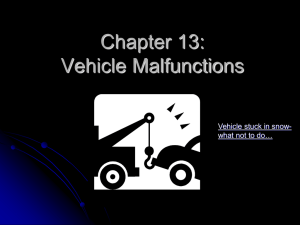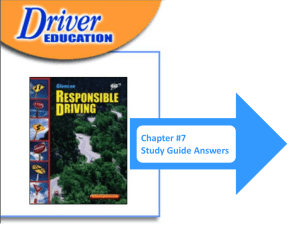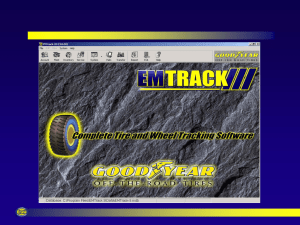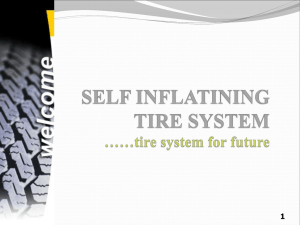A Feasibility Study on Estimation of Tire Force Models from Test
advertisement
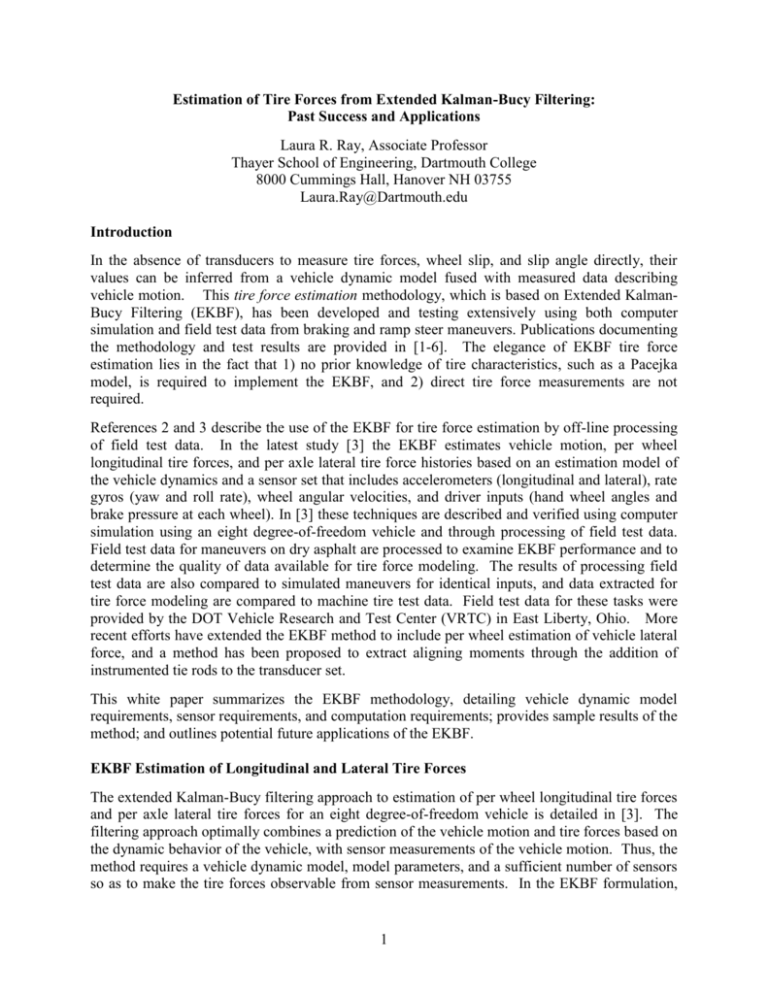
Estimation of Tire Forces from Extended Kalman-Bucy Filtering: Past Success and Applications Laura R. Ray, Associate Professor Thayer School of Engineering, Dartmouth College 8000 Cummings Hall, Hanover NH 03755 Laura.Ray@Dartmouth.edu Introduction In the absence of transducers to measure tire forces, wheel slip, and slip angle directly, their values can be inferred from a vehicle dynamic model fused with measured data describing vehicle motion. This tire force estimation methodology, which is based on Extended KalmanBucy Filtering (EKBF), has been developed and testing extensively using both computer simulation and field test data from braking and ramp steer maneuvers. Publications documenting the methodology and test results are provided in [1-6]. The elegance of EKBF tire force estimation lies in the fact that 1) no prior knowledge of tire characteristics, such as a Pacejka model, is required to implement the EKBF, and 2) direct tire force measurements are not required. References 2 and 3 describe the use of the EKBF for tire force estimation by off-line processing of field test data. In the latest study [3] the EKBF estimates vehicle motion, per wheel longitudinal tire forces, and per axle lateral tire force histories based on an estimation model of the vehicle dynamics and a sensor set that includes accelerometers (longitudinal and lateral), rate gyros (yaw and roll rate), wheel angular velocities, and driver inputs (hand wheel angles and brake pressure at each wheel). In [3] these techniques are described and verified using computer simulation using an eight degree-of-freedom vehicle and through processing of field test data. Field test data for maneuvers on dry asphalt are processed to examine EKBF performance and to determine the quality of data available for tire force modeling. The results of processing field test data are also compared to simulated maneuvers for identical inputs, and data extracted for tire force modeling are compared to machine tire test data. Field test data for these tasks were provided by the DOT Vehicle Research and Test Center (VRTC) in East Liberty, Ohio. More recent efforts have extended the EKBF method to include per wheel estimation of vehicle lateral force, and a method has been proposed to extract aligning moments through the addition of instrumented tie rods to the transducer set. This white paper summarizes the EKBF methodology, detailing vehicle dynamic model requirements, sensor requirements, and computation requirements; provides sample results of the method; and outlines potential future applications of the EKBF. EKBF Estimation of Longitudinal and Lateral Tire Forces The extended Kalman-Bucy filtering approach to estimation of per wheel longitudinal tire forces and per axle lateral tire forces for an eight degree-of-freedom vehicle is detailed in [3]. The filtering approach optimally combines a prediction of the vehicle motion and tire forces based on the dynamic behavior of the vehicle, with sensor measurements of the vehicle motion. Thus, the method requires a vehicle dynamic model, model parameters, and a sufficient number of sensors so as to make the tire forces observable from sensor measurements. In the EKBF formulation, 1 tire forces are treated as unknown state elements of the model, which are to be estimated. The estimation model used for the extended Kalman-Bucy filter is an eight-degree-of-freedom vehicle model with degrees of freedom of longitudinal and lateral translation, rotation about the roll and yaw axes, and four wheel angular rotations. Given a current state, this model predicts the state at the next time step. This prediction is optimally fused with sensor measurements through the Kalman filter equations. The state vector estimated by the filter is composed of translational velocities (v x and v y ) , body fixed yaw and roll rates (r and p), four wheel angular velocities ( fl fr rl rr ) and roll angle (). Per wheel longitudinal tire forces and per axle lateral tire forces and their first time derivatives are augmented as state vector components using a random walk model, as described in [3], resulting in a 21-element state vector. Once longitudinal and per axle lateral forces are estimated, lateral forces are partitioned based on the normal load weight transfer between left and right sides. The vehicle dynamic model used as the estimation model requires parameters that are normally determined through kinematic and compliance testing of the vehicle. In [3], per wheel longitudinal forces and per axle lateral forces are shown to be observable from a sensor set that includes the four wheel angular velocities, roll rate, yaw rate, longitudinal acceleration, and lateral acceleration. The addition of longitudinal and lateral velocity measurements provides slip and slip angle estimates that are also observable through the EKBF. In addition to these sensors, inputs to the vehicle (steering and braking) are assumed to be known through measurements. In past research, the steer input is measured through rack displacement, and roll and compliance steer terms are added to this input to produce individual steer angles at each wheel. Brake line pressures have also been used in past research. Knowledge of the brake pad friction coefficient is required to determine brake torque from brake line pressure, and this relationship is a nonlinear function of velocity. In lieu of accurate data for brake pad coefficient of friction, a constant is normally used. Past results show that the EKBF is robust to assumptions required to estimate brake torque. The EKBF requires sensor noise covariance and process noise characterization for sensors used in order to optimally fuse sensor measurements with vehicle dynamic predictions. Standard test procedures have been developed to derive these quantities from measured data. Given longitudinal and lateral velocity measurements, wheel slip and slip angle estimates are computed from the EKBF state estimate using kinematics. Along with tire force estimates, wheel slip and slip angle can by used to extract force vs. slip characteristics in both longitudinal and lateral directions for quasi-static maneuvers. Normal load at each corner is estimated using a static load transfer approximation and measured accelerations, roll rate, yaw rate, roll angle, and estimated yaw and roll accelerations. Tire force, slip, and normal force histories estimated using the EKBF provide data comparable to that obtained through Flat Trac tire testing. Figure 1 shows sample solicitations for lateral force vs. slip angle and normal load obtained using simulation data for a vehicle as described in [3]. These solicitations are superimposed on the Pacejka model surface for the tire. Here, a ramp steer maneuver is used to obtain quasi-steady lateral force vs. slip angle and normal load data. Each wheel provides a distinctive normal load path, tracing out four paths on the lateral force vs. slip angle vs. normal load tire force curve. Figure 2 shows sample solicitations of lateral force vs. slip angle and normal load from field test data, again superimposed on the Pacejka surface. Curves for two different vehicle loads are provided. Sample data clearly show the ability to extract mu-slip characteristics, including an 2 estimate of the peak of the mu-slip curve. Similar results have been verified for longitudinal force estimation. The current formulation of the EKBF neglects effects of aligning moments. However, the addition of instrumented tie rods to the sensor set has the potential to enable estimation of aligning moment. Given tie rod force coefficients, c z , c y , and c m , tie rod force measurements, EKBF estimated lateral force, and the normal load estimated through the static weight transfer, the aligning moment can be estimated from the tie rod force equation Fl c z Fzfl c y F yfl c m M zfl Fr c z Fzfr c y F yfr c m M zfr (1,2) Applications of EBKF Tire Force Estimation Development work to-date has demonstrated the capacity of the EKBF in evaluation of tire performance within a dynamic environment. Sample applications of EKBF tire force estimation have been evaluated in [4-6]. These applications include estimation of the road friction coefficient using a Bayesian approach, and computer simulation development and evaluation of ABS systems that know the peak traction force. An important near term application of the EKBF approach is evaluation of ABS, traction, and stability control systems during their development and testing phase. The EKBF has the capacity to enable evaluation of such systems by directly inferring the tire force trajectories from test data. Moreover, future potential for realtime implementation of the EKBF can provide tire force and slip estimates in real-time, enabling real time estimation of mu along with tire forces under each wheel. With such estimates, the capacity for novel stability and traction control systems that sense and manage forces at each wheel is enhanced. References 1. L.R. Ray, Nonlinear State and Tire Force Estimation for Advanced Vehicle Control, IEEE Transactions on Control System Technology, pp. 117-124, 3(1) 1995. 2. L.R. Ray, Nonlinear Tire Force Estimation and Road Friction Identification: Field Test Results. 1996 SAE International Congress and Exposition, SAE Paper No. 960181, 1996. 3. L.R. Ray, Nonlinear Tire Force Estimation and Road Friction Identification: Simulation and Experiments, Automatica, pp. 1819-1833, 33(10), 1997. 4. L.R. Ray, Stochastic Decision and Control Parameters for IVHS. ASME International Mechanical Engineering Congress and Exposition, Advanced Automotive Technologies, San Francisco CA, pp. 113-118, 1995. 5. L.R. Ray, Real-Time Estimation of Road Coefficient of Friction for IVHS and Advanced Vehicle Control. Proc. of American Control Conference, pp. 2133-2138, June 1995. 6. L.R. Ray, Estimation of Nonlinear Tire Forces and Road Friction for Modeling and Control. IFAC Workshop on Advances in Automotive Control, pp. 17-22, Napa CA, Feb. 1998. 3 Figure 1 Estimated tire force solicitations from simulation data superimposed on a tire force surface generated using the Pacejka tire model. Legend: fl – front left, fr – front right, rl – rear left, rr – rear right. “True” denotes actual tire forces generated during simulation, and “ekbf” denotes EKBF estimates. 4 Figure 2 Estimated tire force solicitations from field test data for a ramp steer maneuver superimposed on a tire force surface generated using the Pacejka tire model. Two loading cases are provided. Front (top), Rear (bottom) 5

